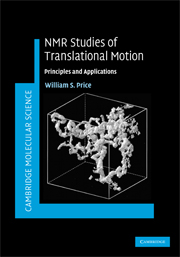Book contents
- Frontmatter
- Contents
- Preface
- Acknowledgements
- Abbreviations
- 1 Diffusion and its measurement
- 2 Theory of NMR diffusion and flow measurements
- 3 PGSE measurements in simple porous systems
- 4 PGSE measurements in complex and exchanging systems
- 5 PGSE hardware
- 6 Setup and analysis of PGSE experiments
- 7 PGSE hardware and sample problems
- 8 Specialised PGSE and related techniques
- 9 NMR imaging studies of translational motion
- 10 B1 gradient methods
- 11 Applications
- Appendix
- Index
- References
5 - PGSE hardware
Published online by Cambridge University Press: 06 August 2010
- Frontmatter
- Contents
- Preface
- Acknowledgements
- Abbreviations
- 1 Diffusion and its measurement
- 2 Theory of NMR diffusion and flow measurements
- 3 PGSE measurements in simple porous systems
- 4 PGSE measurements in complex and exchanging systems
- 5 PGSE hardware
- 6 Setup and analysis of PGSE experiments
- 7 PGSE hardware and sample problems
- 8 Specialised PGSE and related techniques
- 9 NMR imaging studies of translational motion
- 10 B1 gradient methods
- 11 Applications
- Appendix
- Index
- References
Summary
Introduction
This chapter details the instrumentation for generating magnetic gradients and related technical issues. A basic understanding of gradient pulse generation provides insight into spectrometer limitations and related problems. The basic considerations and components of NMR probes and of the generation of high-intensity pulsed field gradients have been reviewed elsewhere. Many of the complications that affect PGSE measurements also apply to imaging experiments, consequently some of the solutions to the technical problems were developed with imaging in mind. Indeed, the design of a B0 gradient probe for diffusion measurements is essentially similar to that of an NMR imaging or microscopy probe except that the gradients used for the B0 gradient probe are often larger and greater precision is required in gradient pulse generation (i.e., pairs of gradient pulses need to be matched to the ppm level). Many high-resolution NMR probes come equipped with gradient coils capable of generating magnetic gradients in the range of 0.5 T m−1, whereas modern high-gradient diffusion probes are capable of generating gradients in excess of 20 T m−1 (Figure 5.1). There is also an interest in making probes capable of performing measurements on samples at high temperature and pressure and for use in solid-state studies.
To perform PGSE measurements, the spectrometer must be equipped with a current amplifier under the control of the acquisition computer which can send current pulses to a gradient coil placed around the sample. The hardware aspects of pulsed field gradient NMR have been discussed by numerous authors.
Information
- Type
- Chapter
- Information
- NMR Studies of Translational MotionPrinciples and Applications, pp. 185 - 197Publisher: Cambridge University PressPrint publication year: 2009
